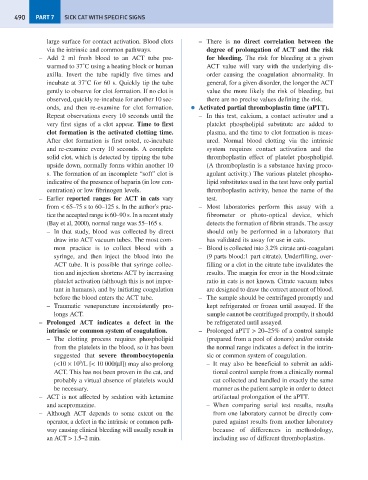Page 498 - Problem-Based Feline Medicine
P. 498
490 PART 7 SICK CAT WITH SPECIFIC SIGNS
large surface for contact activation. Blood clots – There is no direct correlation between the
via the intrinsic and common pathways. degree of prolongation of ACT and the risk
– Add 2 ml fresh blood to an ACT tube pre- for bleeding. The risk for bleeding at a given
warmed to 37˚C using a heating block or human ACT value will vary with the underlying dis-
axilla. Invert the tube rapidly five times and order causing the coagulation abnormality. In
incubate at 37˚C for 60 s. Quickly tip the tube general, for a given disorder, the longer the ACT
gently to observe for clot formation. If no clot is value the more likely the risk of bleeding, but
observed, quickly re-incubate for another 10 sec- there are no precise values defining the risk.
onds, and then re-examine for clot formation. ● Activated partial thromboplastin time (aPTT).
Repeat observations every 10 seconds until the – In this test, calcium, a contact activator and a
very first signs of a clot appear. Time to first platelet phospholipid substitute are added to
clot formation is the activated clotting time. plasma, and the time to clot formation is meas-
After clot formation is first noted, re-incubate ured. Normal blood clotting via the intrinsic
and re-examine every 10 seconds. A complete system requires contact activation and the
solid clot, which is detected by tipping the tube thromboplastin effect of platelet phospholipid.
upside down, normally forms within another 10 (A thromboplastin is a substance having proco-
s. The formation of an incomplete “soft” clot is agulant activity.) The various platelet phospho-
indicative of the presence of heparin (in low con- lipid substitutes used in the test have only partial
centration) or low fibrinogen levels. thromboplastin activity, hence the name of the
– Earlier reported ranges for ACT in cats vary test.
from < 65–75 s to 60–125 s. In the author’s prac- – Most laboratories perform this assay with a
tice the accepted range is 60–90 s. In a recent study fibrometer or photo-optical device, which
(Bay et al, 2000), normal range was 55–165 s. detects the formation of fibrin strands. The assay
– In that study, blood was collected by direct should only be performed in a laboratory that
draw into ACT vacuum tubes. The most com- has validated its assay for use in cats.
mon practice is to collect blood with a – Blood is collected into 3.2% citrate anti-coagulant
syringe, and then inject the blood into the (9 parts blood:1 part citrate). Underfilling, over-
ACT tube. It is possible that syringe collec- filling or a clot in the citrate tube invalidates the
tion and injection shortens ACT by increasing results. The margin for error in the blood:citrate
platelet activation (although this is not impor- ratio in cats is not known. Citrate vacuum tubes
tant in humans), and by initiating coagulation are designed to draw the correct amount of blood.
before the blood enters the ACT tube. – The sample should be centrifuged promptly and
– Traumatic venepuncture inconsistently pro- kept refrigerated or frozen until assayed. If the
longs ACT. sample cannot be centrifuged promptly, it should
– Prolonged ACT indicates a defect in the be refrigerated until assayed.
intrinsic or common system of coagulation. – Prolonged aPTT > 20–25% of a control sample
– The clotting process requires phospholipid (prepared from a pool of donors) and/or outside
from the platelets in the blood, so it has been the normal range indicates a defect in the intrin-
suggested that severe thrombocytopenia sic or common system of coagulation.
9
(<10 × 10 /L [< 10 000/μl]) may also prolong – It may also be beneficial to submit an addi-
ACT. This has not been proven in the cat, and tional control sample from a clinically normal
probably a virtual absence of platelets would cat collected and handled in exactly the same
be necessary. manner as the patient sample in order to detect
– ACT is not affected by sedation with ketamine artifactual prolongation of the aPTT.
and acepromazine. – When comparing serial test results, results
– Although ACT depends to some extent on the from one laboratory cannot be directly com-
operator, a defect in the intrinsic or common path- pared against results from another laboratory
way causing clinical bleeding will usually result in because of differences in methodology,
an ACT > 1.5–2 min. including use of different thromboplastins.

